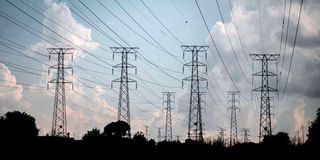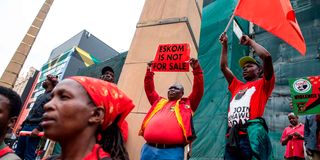Prime
The dead feel the heat of South Africa’s power crisis

An Avalon Cemetery worker digs a grave in the graveyard section at the Avalon Cemetery in Soweto on November 15, 2018, in Johannesburg, South Africa. South Africa’s severe power outages have placed enormous strain on the country’s crematoria and morgues as bodies have begun to pile up and decay before cremation and internment.
What you need to know:
- Authorities are unwilling to discuss the problems at crematoria and morgues due to legal requirements for the privacy of the information of both those who have passed away and more particularly their families.
- For most of the country’s funeral parlour industry, the real pressure is in the pocketbook as the cost of keeping bodies at cold-room temperatures, due to ongoing electricity blackouts.
- Eskom has repeatedly said it will take “two to three years” to get its old, poorly-maintained power plants, and its newer, but poorly-built plants, operating collectively at about 70 per cent electricity availability.
South Africa’s severe power outages, again this week back to historically high levels, have placed enormous strain on the country’s crematoria and morgues as bodies have begun to pile up and decay before cremation and internment.
S. Africa has endured a higher level of load-shedding so far this year than any preceding it, and in late January and early February, also experienced record heatwaves across parts of the country, causing a logjam in processing dead bodies at morgues, undertakers and crematoria.
While the heat waves, with many areas recording well over 40 degrees Celsius for several days in succession, have since abated, the power outages have, if anything, worsened.
Authorities are unwilling to discuss the problems at crematoria and morgues due to legal requirements for the privacy of the information of both those who have passed away and more particularly their families.
One crematorium worker, who declined to be named as workers are not allowed to speak directly to media, said the situation was comparatively “worse” than the height of the Covid pandemic because the heat and extended outages meant that more bodies were being held than could be disposed of and that “some are beginning to rot” due to outages.
The last time crematoria and undertakers were so backlogged was in the late summer of August 2021, when a wave of Covid deaths overwhelmed facilities. Then, families were forced to wait up to a month to bury their dead.
But the combination of multiple outages daily, and hot weather, has meant that rather than delay burials, families and undertakers are being encouraged to bury the dead as quickly as possible, and in any event, “less than four days”.

In this file photo taken on February 16, 2022, A woman uses a rechargeable LED lantern to illuminate a shoe rack while shopping at the Sinnoville Centre after its electricity supply was cut off by the City of Tshwane (COT) municipality for allegedly having a bill of 16 Million South African Rands, in Pretoria.
Maitland Crematorium, which services much of Cape Town, was during Covid waves experiencing major backlogs, due to an increase in both natural death and Covid-19-related fatalities, while some private graveyards were then also waterlogged due to heavy rainfall.
At Maitland, while the number of bodies awaiting disposal has dropped to “normal” levels, the ability to maintain them has not kept pace.
Cape Town’s weather and most other major centres have moderated from the extreme highs of a few weeks ago, but the problem of dealing quickly with bodies that cannot be properly stored in refrigerated conditions due to outages has not eased at all.
Faster decay
Unrelenting load shedding, coupled with high summer temperatures, continues to cause bodies to decay much faster than normal, where backup power for cadaver storage was unavailable, being most facilities nationwide, one industry body has warned.
The South African Funeral Practitioners Association’s (SAFPA) national secretary-general Vuyisile Mabindisa now wants people to bury their loved ones within four days of their death, in order to ease pressure on funeral parlours and to ensure that they are buried with minimal decay.
“The industry is seeing a large number of putrefied bodies being buried. Burying one’s kin within four days, or less, is cost-effective and prevents families from seeing their departed ones in a poor state of decomposition,” he says.
S. Africa experienced over 200 days of load shedding in 2022, but every day of 2023 has so far seen load shedding, including another current extended period of ‘Stage 6’, wherein power may be out for 4.5 hours at a time, sometimes longer, and more than once a day.

South Africa's main opposition party Democratic Alliance (DA) party members chant during their march to the Union Buildings in Pretoria on March 29, 2018. The march aims at protesting against energy giant Eskom and the looming electricity tariff hike of over 9.4 per cent.
This means that backup power via diesel generators is very expensive or not viable to maintain cold conditions for numerous bodies at a time.
Mabindisa said the heatwaves S. Africa has experienced this summer, along with extremely intense downpours, were causing the rate of decomposition of bodies awaiting burial or cremation to “skyrocket”.
For most of the country’s funeral parlour industry, the real pressure is in the pocketbook as the cost of keeping bodies at cold-room temperatures, due to ongoing electricity blackouts but also the high cost of what electricity there is available which is cutting into profits and causing some smaller undertakers to consider closing down.
Subsidies plea
South African Chamber of Undertakers Chairman Nhlanhla Bembe says funeral parlours are spending around $40 per day to power generators, the organisation saying the government needed to offer subsidies to cover the cost of diesel for backup power.
“Loadshedding has been catastrophic for the funeral industry and it has become very expensive to keep human remains because we have to pay for electricity and buy diesel for generators to power cold rooms,” he explains.
At one funeral parlour in Johannesburg, the owner says instead of spending money on more diesel, a larger number of bodies bound for the grave were being embalmed.
“When the fridges are not working, we are now faced with embalming bodies. It brings more costs. With load-shedding it’s making life more difficult for us,” this funeral operator, Leon Matshiza, explains.
And the problems wrought upon morgues by darkness are not stopping at decomposing bodies.
Major funeral homes, some with operations across the country and the ability to provide supplemental diesel-powered electricity to their operations, have become targets of criminal elements who steal computers, laptops, cables, equipment washbasins, and anything else to hand, according to complaints from the hard-pressed operators.

In this file photo taken on November 26, 2022, Electric poles are seen in Soweto. - South Africa's President Cyril Ramaphosa declared a national disaster on February 9, 2023, in a bid to fast-track efforts to tackle a record electricity shortage that has put the brakes on economic growth in Africa's most industrialised economy.
Coping with daily outages using diesel generators has also not been viable in some parts of the country, where outages have run from days to weeks.
Komani, a mid-ranged-sized town in the Eastern Cape province, is an example of many such a place.
The town experienced a three-week-long outage in December, said the National Funeral Directors Association (NFDA), a severe stressor on local businesses of all kinds, including funeral parlours.
Criminal gangs
That situation arose from another knock-on of the daily outages, during which criminal gangs attack electrical substations, knowing they stand little to no chance of being electrocuted, or even being interrupted by authorities, while they strip these distribution hubs of their copper cabling.
A recent cell phone video, shot by a concerned citizen and which went viral, shows a cable theft gang operating in plain view, without apparent concern for being apprehended.
The administration of President Cyril Ramaphosa has taken steps to outlaw copper and other critical metals’ export.

South African President Cyril Ramaphosa.
But the copper cable theft ‘industry’ is alive and well, as evidenced by the apprehension in the last month of two separate cable-theft syndicates, one allegedly involving police officers said to have been ‘standing watch’ while syndicate members ripped out and stole critical cables at a substation.
Such crimes, ‘committed under cover of darkness’ during Eskom blackouts, result in large areas, with tens to hundreds of thousands of people and businesses affected, being left powerless for days, more usually weeks, at a time.
This week, pressurised Eskom officials, once again presenting a multi-hour press conference, in effect to the whole country, could not offer fellow citizens the prospects of an easing in outages any time soon – eight more units have gone down, some inexplicably, on Sunday alone.
Eskom has repeatedly said it will take “two to three years” to get its old, poorly-maintained power plants, and its newer, but poorly-built plants, operating collectively at about 70 per cent electricity availability.

A man holds a sign saying that Eskom, the South African electricity public utility, is not for sale during a demonstration by members of the Congress of South African Trade Unions (COSATU) on February 13, 2019 in Johannesburg, South Africa.
The electricity availability figure, before this past weekend’s latest failures, was around 53 per cent.
This means that, although S. Africa has a theoretical installed capacity almost twice its peak daily need of around 32-33GW, it is still falling short by around 6GW and is now planning to import electricity from Zambia and Mozambique, sufficient to close half the existing gap between demand and supply, while racing to build independent power-producer wind- and solar-powered installations to feed the energy-starved national grid.





